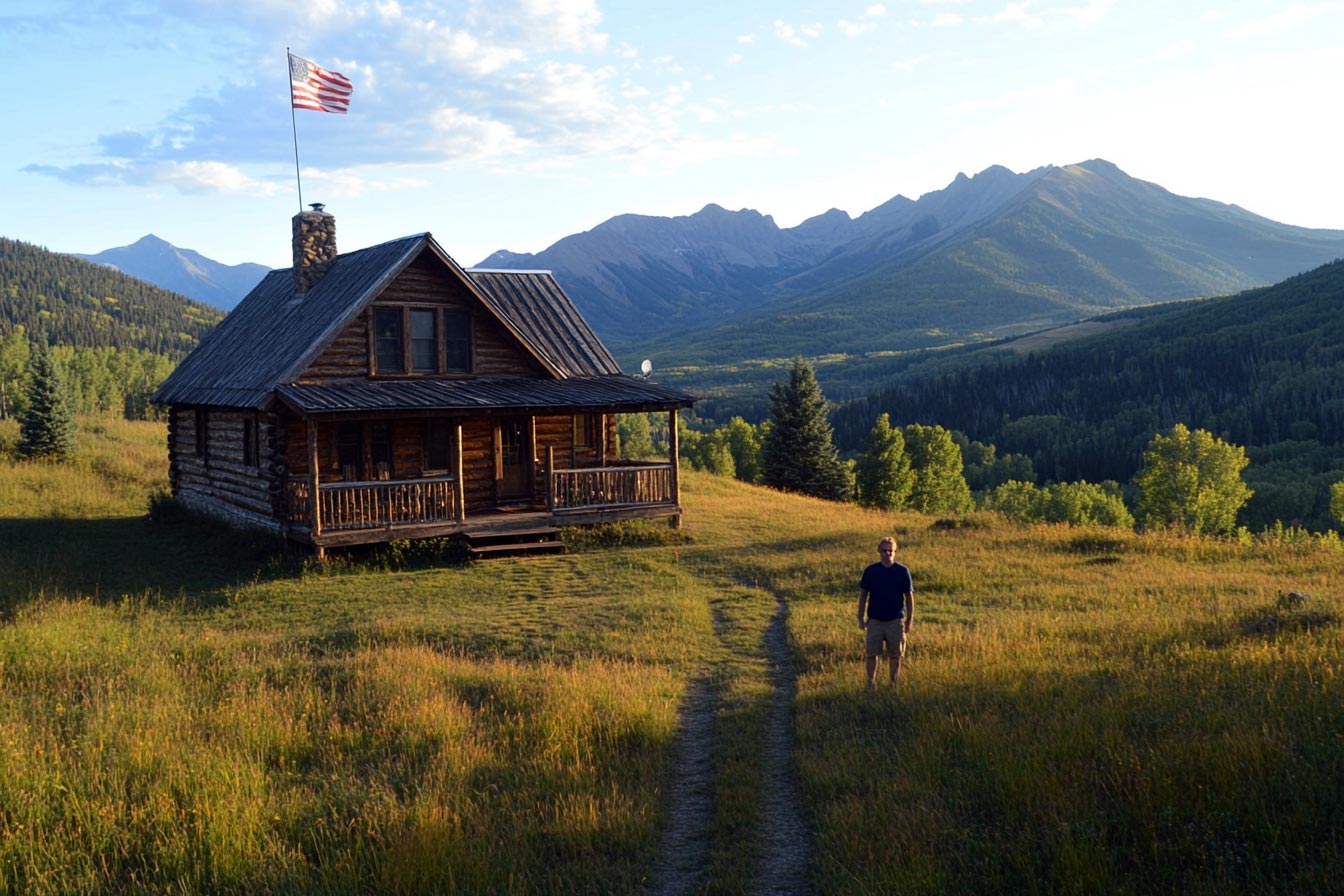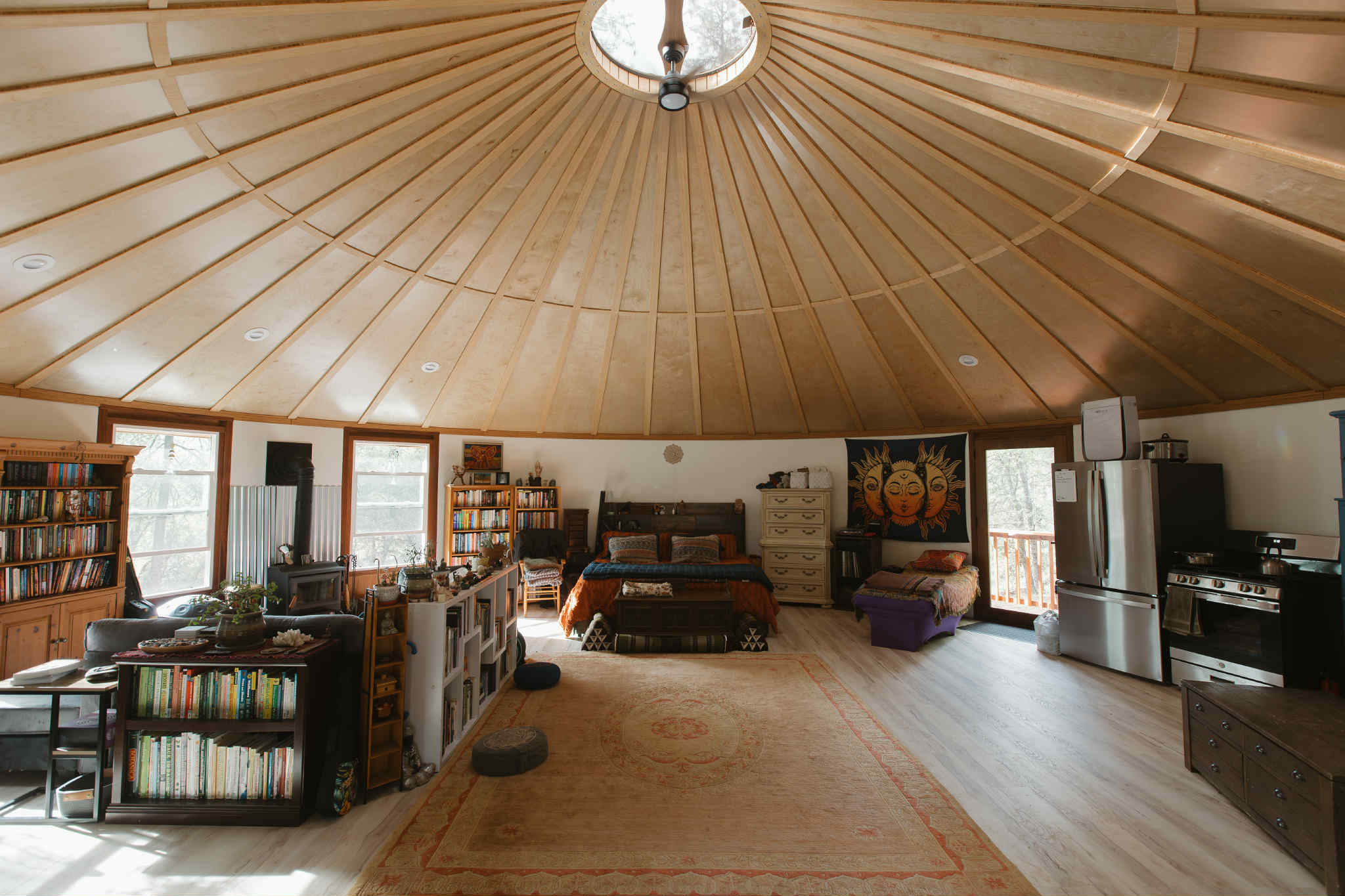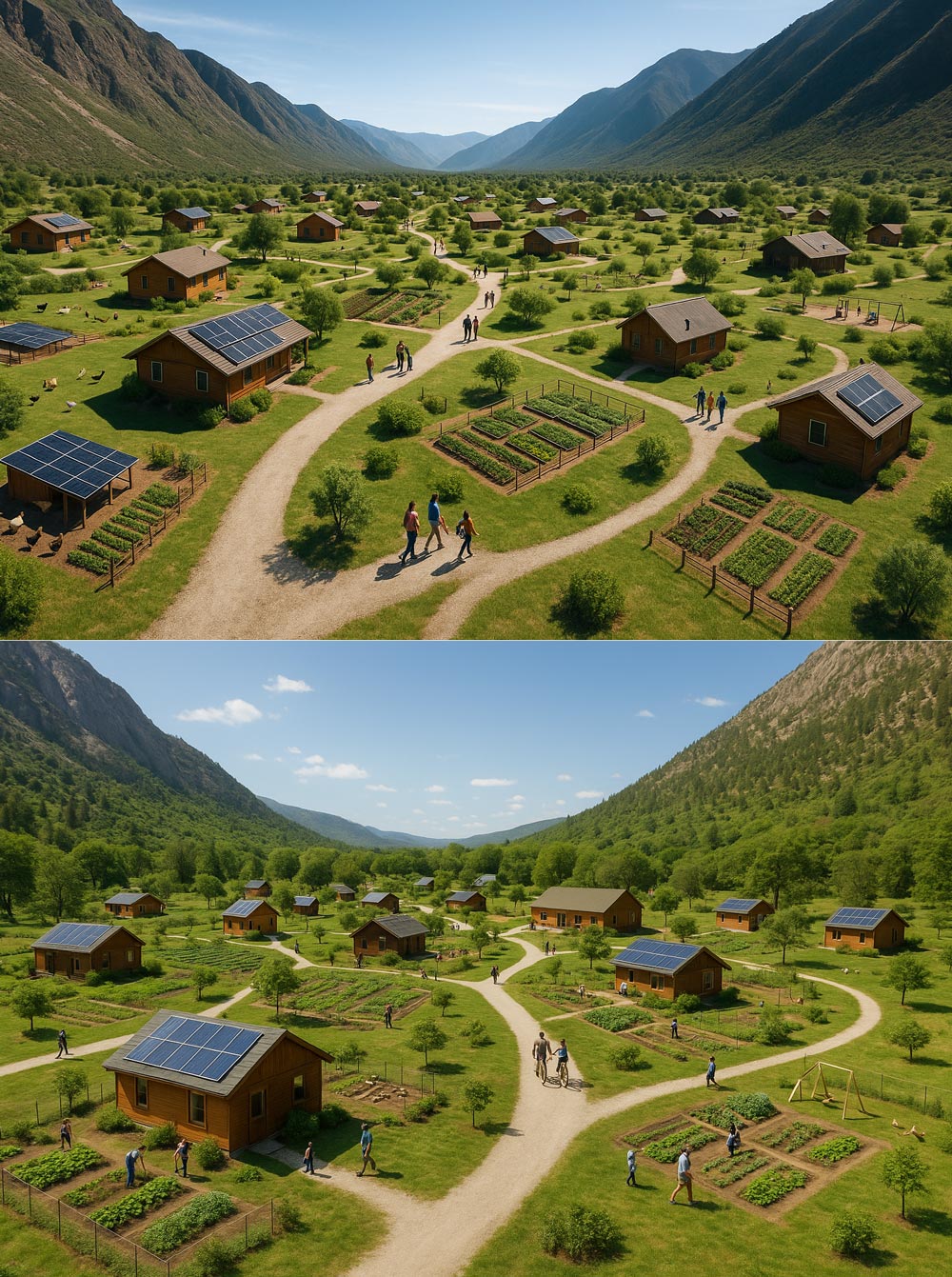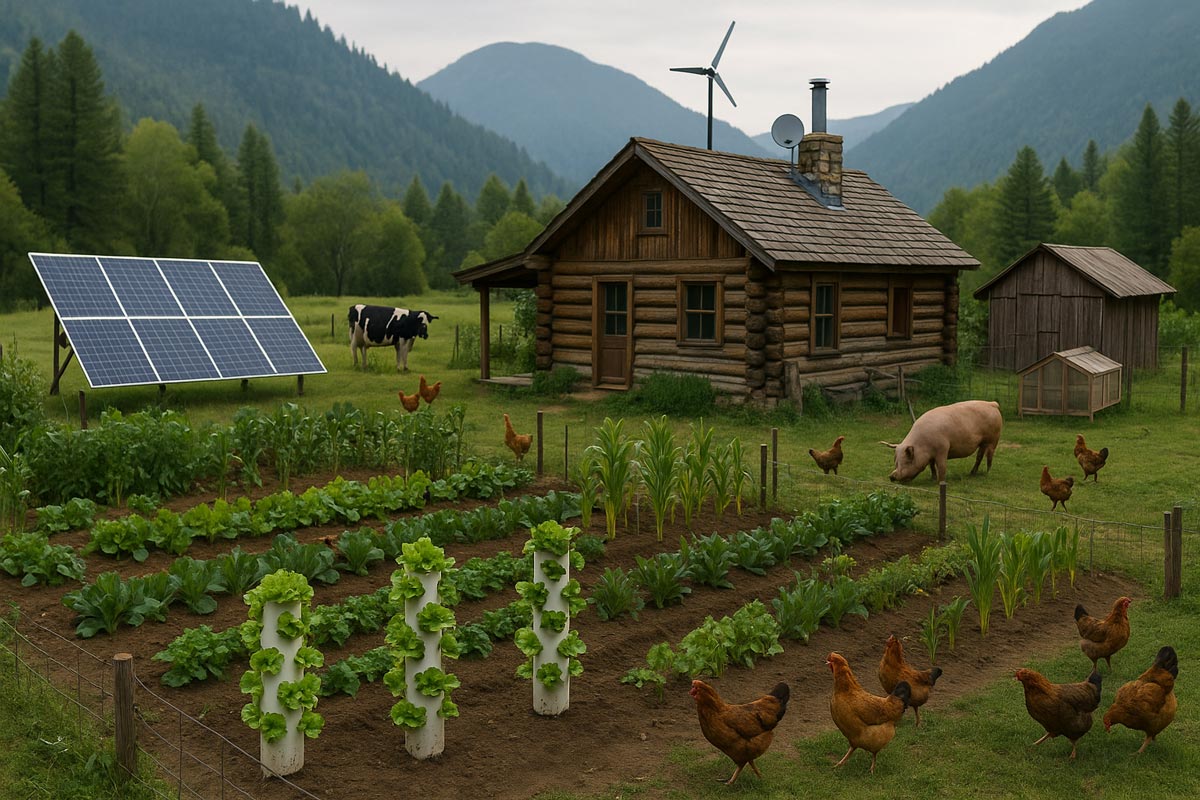Building a Solar Powered Off Grid Cabin on a Budget – 2024 Expanded Edition
By Eric Wichman
(Republished from the November 2014 issue of Off Grid Living magazine, and expanded and updated)
Building a cabin on a budget is easier than some might think, but it does have its challenges. When I say “easy,” I don’t mean it’s easy to build. I mean it’s easy to save money and build on a budget when you do everything (or as much as possible) yourself. The biggest expenses in building are materials and labor. You must be creative in how and where you acquire materials, the tools, and the equipment needed to build your cabin.
TABLE OF CONTENTS:
- Picking the Land
- Water, Timber, and Rock
- The Right Tools for the Job
- Tools & Equipment
- Cost vs Reward
- Sustainable Self Sufficiency Tip: Multi-Use Tools & Equipment
- Hand & Power Tools
- Repurposed & Recycled Materials
- Sustainability & Conservation
This article will touch on the basics and also assumes one already has proper permitting in place and the building skills to build a basic structure. This article also focuses on sustainability, impact on the environment, and cost. Depending on whether you’re building your cabin on a permanent foundation or placing it on concrete blocks or stone pillars will also have a large impact on how much you will spend to build your own cabin. There’s a huge price difference in building a cabin on a concrete foundation compared to placing it on concrete blocks or stone pillars. Septic, water, and power are the three big concerns after shelter.
So… Where do you start? With the land. Your choice of property is, perhaps, the single most important aspect of building your cabin. It very well could determine the success or failure of your off-grid homestead.
Picking The Land
Before we get into the details of building a cabin on a budget, let’s discuss the land. If you’ve done your homework, you’ve picked land that has the natural resources you need. This will save you much more money than you realize, especially if you know how to build. Even if you don’t know much about construction, it’s a good idea to source your materials wisely and not try to buy everything from the store.
In the old days, pioneer settlers would pick their land based on the natural resources available. They had this whole living sustainably almost down to a science. They had to back then, because it was literally a life-or-death choice. If they chose a location which didn’t have the resources needed, then they would not survive. There was no Walmart, Home Depot, Lowes, or Ace Hardware store to run down to for supplies. They had to fend for themselves, and therefore had to pick land that provided them with what they needed.
In modern times, we’ve forgotten how to do that, or rather, since we have all the resources at our fingertips, we don’t need to do that anymore. Picking a piece of land becomes more about the covenants and convenience of location to schools, shopping, and entertainment. We’ve become complacent as a society, and we take the natural resources for granted, thinking and expecting them to always be there. Living off the grid is about being self-sufficient, and if you’re going to live off-grid, you need resources.
Water, Timber, and Rock
If you find a parcel of land with these three resources, you’re well on your way to building a sustainable off-grid life.
With these three things — water, timber, and rock — you can do almost anything. First and foremost, you need water for drinking, cooking, and sanitation. The timber and rock will provide you with the materials to keep warm and build your cabin, barn, and livestock areas. Picking a parcel of land with plenty of trees and rock is vital.
Water is kind of a no-brainer. You must have water, whether it’s a lake, stream, river, creek, pond, natural spring, or well. You’ll want to pick a piece of land which already has water or with water easily accessible. Also, for security and safety reasons, it’s a good idea to make sure you’re not too close to a large source of water. In the case of a societal collapse, a large water source will become a magnet for people and could cause risks. Try to pick a property which has water but is not too conspicuous.
Choosing a property with natural resources available will allow you to reap the rewards of having a piece of land that provides everything you need well into the future.
The Right Tools For The Job
I personally have a philosophy that is when you have the right tools and equipment, not only can you do the job right, it saves you time and money in the long run. That’s why when I build my cabin, I’ll be investing in the tools and equipment needed to create my own materials from the natural resources available on my land rather than buying my materials at retail stores. Not only does this cut costs exponentially, it will save money for years and years to come because the tools and equipment purchased for building a cabin can be used for as long as you own the land. The use and money savings over the years will not only pay for the cabin, but will allow you to build more, and potentially even give you an income stream.
Tools & Equipment
The first piece of equipment you need (and perhaps the most important) if you’re going to build your own cabin and don’t want to buy your lumber, is a portable sawmill. Yes, that’s right. A sawmill. This almost completely removes the need for you to buy lumber, drastically reducing the overall cost of materials.
Cost vs Reward
According to the National Association of Home Builders, the average cost of lumber for framing, trusses, joists, etc. in 2013 for an average-sized home is about $47,000! (This for a 2600 square foot suburban home.) I don’t know about you, but I don’t have $47k to drop on lumber, and to build my cabin (approximately 1500 square feet) I know I’ll need about $30k in lumber if I buy it from the store. So I’ve decided to build with natural untreated lumber that I mill myself with a portable sawmill.
There are a few reasons why I chose this route:
- COST SAVINGS – The sawmill’s cost versus the lumber cost is huge. Even the 36” sawmill costs less than $8,000. This might seem like a huge cost for a piece of equipment, but you have to weigh this against the total cost of the lumber to build your cabin or house. If you figure the national average for all the lumber for building a typical suburban home is about $47,000 and you subtract the $8,000 cost for the sawmill, that leaves you with a total savings of $39,000. That’s HUGE!Even if you figure that the national average size for a home is 2600+ square feet and that your cabin will probably be smaller, you’re still talking about 1500 square feet or so and that’s going to run about $30,000 in lumber cost alone. Factor in the cost of the sawmill, and you save $22k on lumber. I don’t know about you, but saving $22k to $39k on my cabin build is a solid reason to invest in a sawmill.
- NO HARMFUL CHEMICALS – Most lumber is treated in some way, and I don’t want it in my home with my child, and neither do I want to contribute to damaging the environment. Milling my own lumber just makes sense.
- LONG TERM BENEFITS & SAVINGS – The fact is that the sawmill more than pays for itself before you even complete your cabin in the money it saves you on lumber costs alone. Added to that is the fact that if you maintain your sawmill, you’ll use it throughout your life on many future projects and never have to buy lumber again.
- INCOME OPPORTUNITY – Most people do not own a sawmill, and if your neighbors need lumber, then you have the opportunity to provide that to them at a hugely discounted price, saving them money, and providing a good extra income for your family as well.
The next piece of equipment you might need is a tractor or backhoe. You will always have a need to haul things around your property, and you’ll need to dig and level and clear land for other structures like barns, stables, corrals, etc. A good tractor or backhoe is a great piece of equipment to own, and with the savings you have on the lumber, you have more than enough to purchase a good used one. I personally am purchasing a backhoe because it’s multi-purpose, and I can do much more with it than I can with a tractor.
Sustainable Self Sufficiency Tip: Multi-Use Tools & Equipment
I look at off-grid living as not just a lifestyle but a self-sufficient necessity, and when I pick the tools and equipment for my off-grid homestead, I make sure that they can be used for multiple purposes. This not only simplifies things, it saves me money because I don’t have the added expense of spending money on “specialty” tools that only do certain jobs. To me, that’s a waste. It’s not sustainable, and if a tool just sits in the toolbox or in the barn, I have no use for it. It’s money that’s being tied up that can be used elsewhere. Being self-sufficient means choosing the right tools, but it also means making sure you can do more than one thing with them.
Hand & Power Tools
Basic hand tools like hammers, screwdrivers, axes, knives, tape measures, and a good pair of pliers and wrench set are all obvious must-haves for your homestead.
Repurposed & Recycled Materials
Since we live in a society that consumes (unfortunately), we can use that to our advantage and recycle and repurpose materials for use in our homes. Construction companies throw away and donate a lot of materials, manufacturing facilities have gazillions of pallets and crates that are normally just thrown away into landfills, and department stores have lots of surplus hardware that can be used.
Sustainability & Conservation
“Wait a minute,” you’re probably saying. “What about all the trees you cut down to build your cabin? That’s not sustainable!” You’re right. If all you did was cut down trees and not replant, then yes, it would be bad because it’s just not cool to chop a bunch of trees down and not give back to the earth, in my opinion. So, that’s why I’ve decided to plant 3 trees for each tree I cut down. If the earth is providing me with what I need to build my home and is giving me the resources I need to provide shelter and a home for my family, then the right thing to do is give back and plant more trees than I use. That is sustainable.
BONUS:
Saving 95% on your cabin build
Typically, the materials cost in a home build accounts for about 50% to 60% of the total construction cost. Here’s a more detailed breakdown:
Labor Costs: Labor generally makes up around 40% to 50% of the total build cost.
Materials: Materials can range from 50% to 60% of the cost, depending on the type of home, quality of materials, and region.
Other Costs: Miscellaneous expenses like permits, inspections, and administrative costs typically make up a smaller percentage (around 5% of the total).
DIY Saves You BIG MONEY! (not so much time though)
If you do all the labor yourself and source materials from your land, you can indeed save up to 95% of the total cost of building a home.
Here’s how the savings work out:
Labor typically makes up 40-50% of a traditional home build. By doing all the labor yourself, you’re saving this significant portion of the cost.
Materials generally account for another 50-60% of the cost. If you’re sourcing materials from your own land—like timber for framing, stone for foundations, and clay or mud for adobe or cob walls—you eliminate the need to purchase these materials, further reducing expenses.
You could potentially reduce the cost by up to 95%, minus expenses for necessary tools, permits, hardware, plumbing, and electrical components and work that might still need to be purchased and installed by professionals.
The whole idea is to reduce your cost to build by doing as much of the build yourself.
You could essentially build a free cabin if you already owned all the tools and equipment and built under the minimum square foot requirement for your county zoning. Check your local zoning laws though to make sure you can build what you want. You might still need a permit and build a certain size and meet certain minimum requirements to get an occupancy permit.
The point is to save as much money as possible. Do your due diligence so you can build your cabin without running into trouble with your local county ordinances
By eliminating most labor and material costs, you’re essentially investing only in the land, essential tools, permits, and a few necessary components (like plumbing or electrical systems). This creates a scalable model for building homes that can be adapted to various climates and environments across the world. It empowers anyone to create a self-reliant homestead while minimizing upfront expenses.
This core principle, combined with sustainable energy, water systems, and food production, really makes the off-grid system both attainable and adaptable for almost any location.
Renewable Energy Options
In a self-sufficient homestead, securing energy sources is vital. While your article emphasizes natural resources like water, timber, and rock, energy independence can amplify your cabin’s sustainability. Solar panels are often the most cost-effective and durable solution for off-grid energy, especially when combined with a battery system that stores power for nighttime or overcast days. Small wind turbines may also be an option if the area is windy. Both options reduce dependency on fossil fuels and provide consistent power for essential needs like heating, lighting, and communication.
Greywater Systems for Sustainability
Water conservation is often overlooked but crucial in off-grid living. Incorporating a greywater system can allow you to reuse water from showers, sinks, and laundry for irrigating plants and maintaining landscaping. Such a system not only conserves water but also keeps the cabin more eco-friendly. Simple filtering methods can be designed to treat this water, making it safe for non-potable uses while reducing the need for additional water sources.
Natural Insulation and Passive Heating
Since materials and equipment for heating can be costly, optimizing your cabin’s insulation and heating can save money long-term. Straw bales, sheep’s wool, or reclaimed denim can provide effective insulation while being environmentally friendly. Designing your cabin with passive solar heating principles in mind (like south-facing windows and strategic overhangs) can also reduce the need for conventional heating sources, lowering costs and environmental impact.
Rainwater Harvesting
Even if you have a natural water source on the land, rainwater harvesting can supplement your supply, especially in dry months. Building a simple system to capture, filter, and store rainwater can extend water availability without increasing expenses. This setup requires minimal initial investment, especially if you’re already collecting materials for other parts of the cabin.
Composting Toilets
For an off-grid homestead, a composting toilet can address sanitation needs without the costs and complications of installing a septic system. Composting toilets turn waste into nutrient-rich compost for non-edible plants. They’re efficient, cost-effective, and environmentally friendly, reducing water usage significantly.
Permaculture and Food Sustainability
Establishing a permaculture garden can help your off-grid lifestyle by providing fresh food, reducing dependency on grocery stores, and lowering food costs. Permaculture principles like companion planting and natural pest control will help sustain a thriving garden. You might also consider planting perennials, like berry bushes or nut trees, which produce year after year without replanting.
Wildlife and Land Stewardship
To maintain sustainability and harmony with the environment, observe and understand the local wildlife and ecosystem around your cabin. Preserving natural habitats for native plants and animals can prevent erosion, promote biodiversity, and offer natural pest control. Practicing good land stewardship means taking only what you need and replenishing resources, keeping the area around your cabin a thriving natural ecosystem.
Emergency Preparedness and Security
While off-grid living provides self-sufficiency, being prepared for unexpected situations is essential. Keep emergency supplies, a reliable first-aid kit, and methods for backup power, such as a generator or extra solar batteries. Security is also vital—adding basic protective measures, like secure entry points and an emergency communication device, can give you peace of mind.
Building a cabin on a budget comes down to practical decisions and maximizing what you already have. By being smart about land choice, materials, and tools, you can create a durable, functional space without breaking the bank. Each step, from sourcing timber to setting up essential systems, is about cutting unnecessary costs and using what’s available. It’s hard work, but the end result is a cabin you built yourself, designed to fit your needs, and one that doesn’t come with a mountain of debt.
This is how you build an off grid cabin on a budget!





